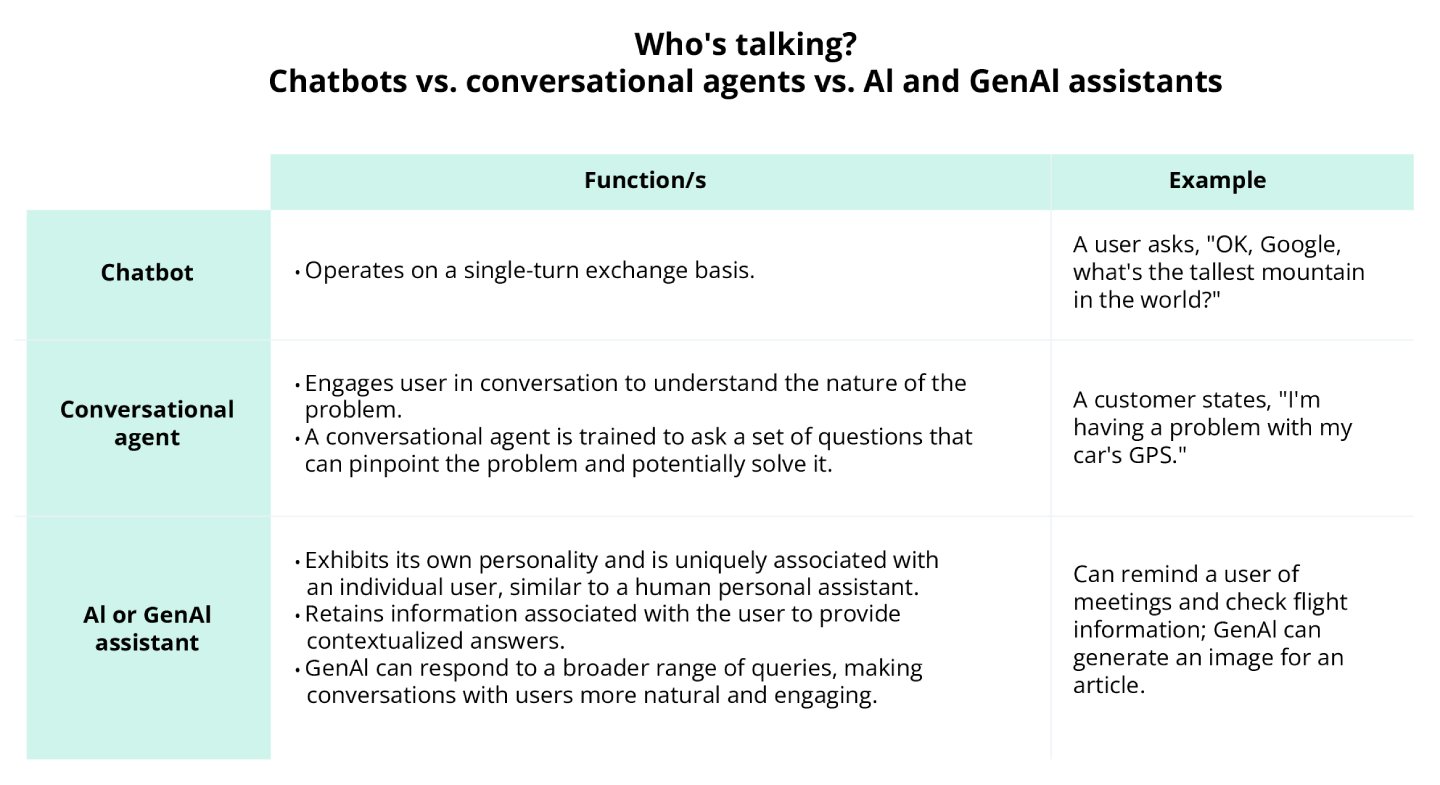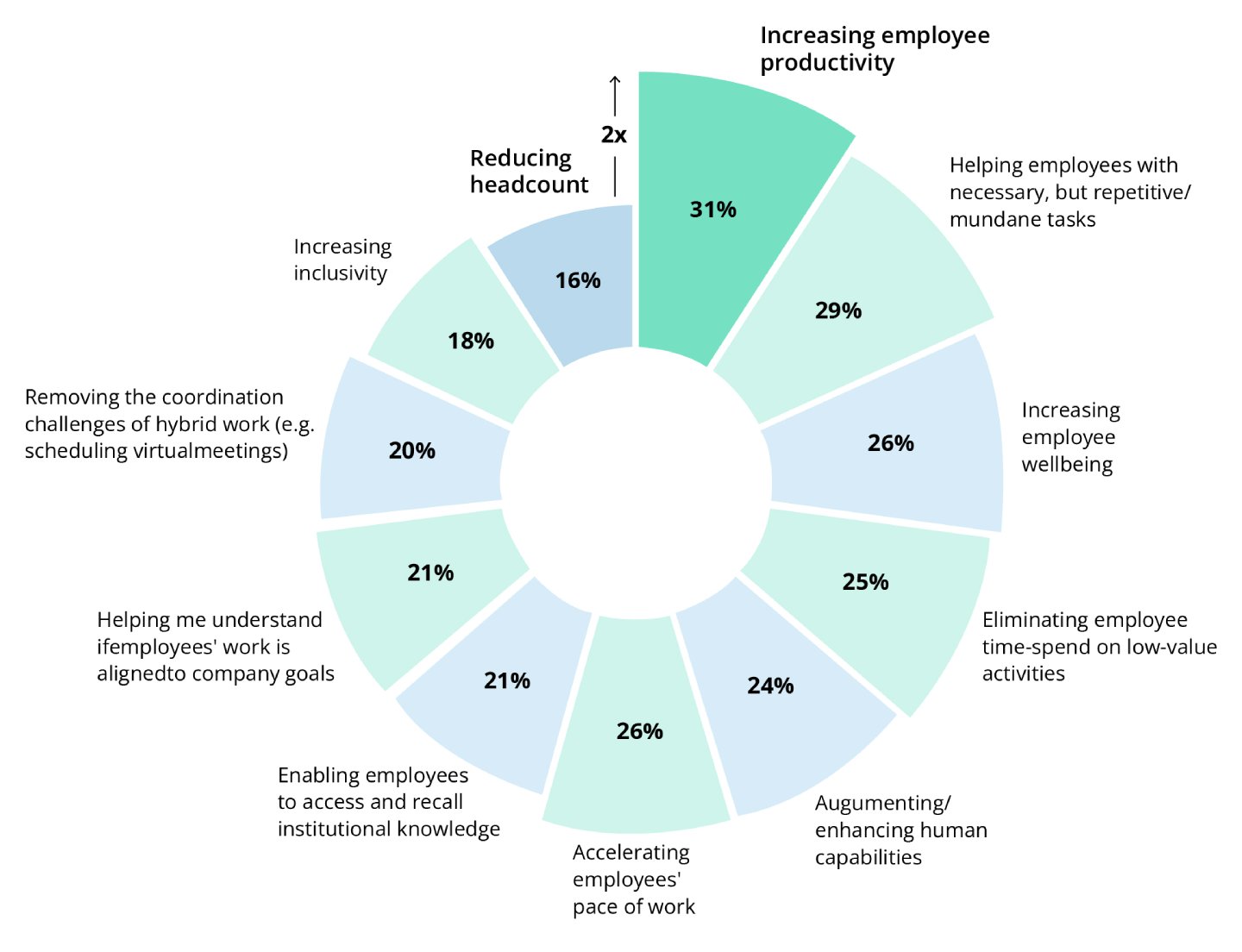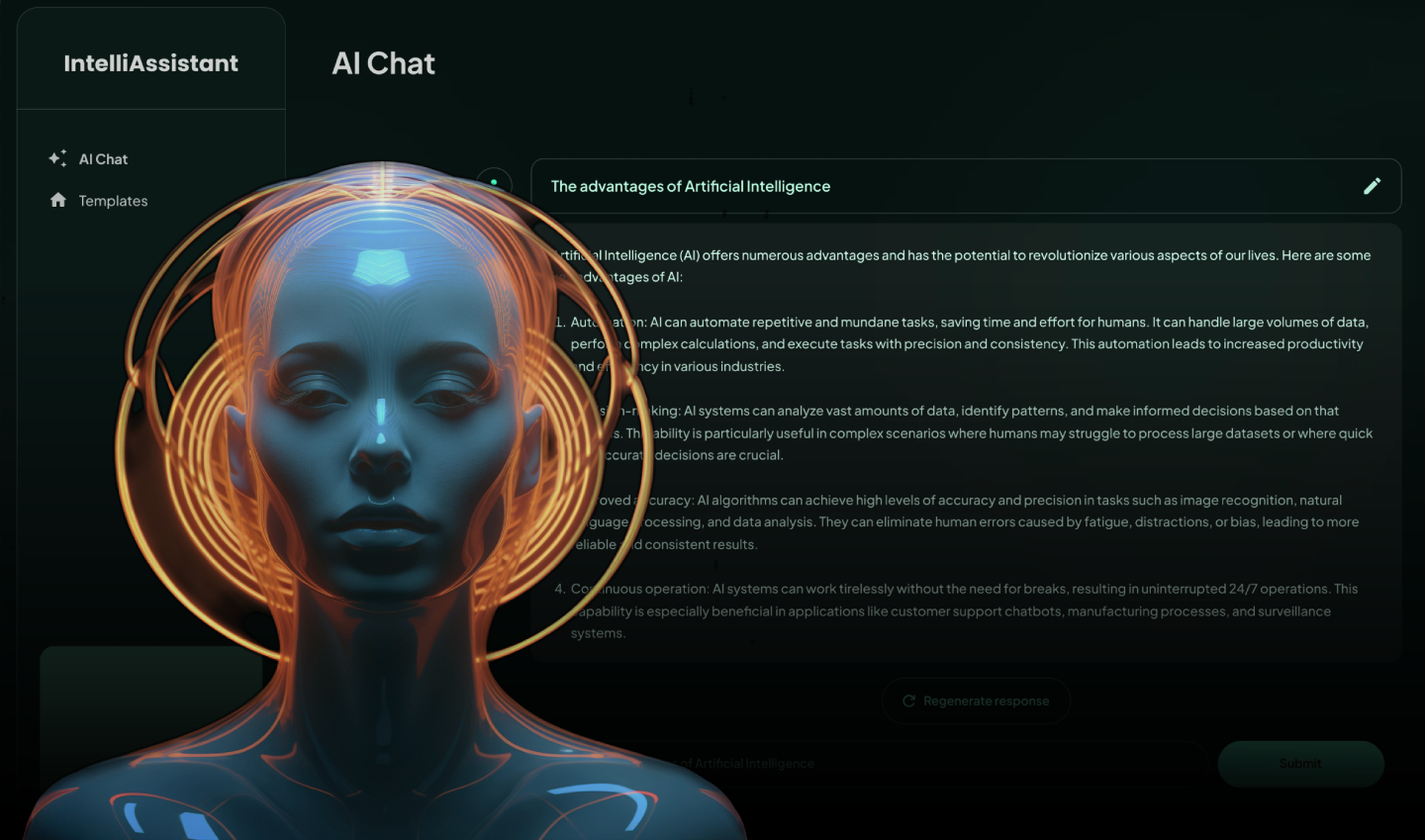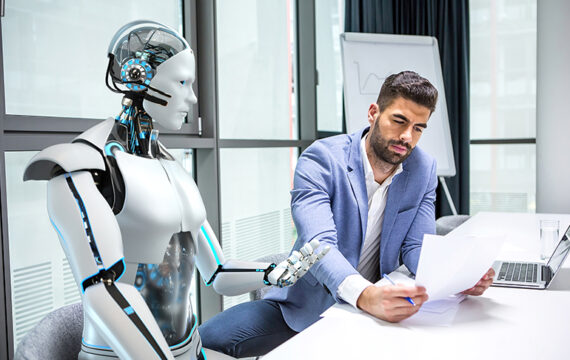Concentrating all workplace motivation efforts around compensation and rewards is no longer a successful approach. While money may have offered sufficient motivation in the past, employees now seek satisfaction and a sense of purpose from their jobs.
AI-powered virtual assistants offer a smarter approach to motivating your employees. They foster knowledge sharing and purpose-driven work, provide on-the-spot support, handle tasks with precision and take tedious administrative duties off people’s shoulders. This frees up human workers to focus on more strategic aspects of their jobs.
AI is no longer a futuristic concept but an integral part of the modern workplace, helping to automate repetitive tasks and improve decision-making. There are many concerns about AI taking away human jobs, but the real value of AI productivity assistants is in augmenting human intelligence, not replacing it.
What is an AI assistant for work?
Imagine a bustling office where everything runs smoothly. Emails get sorted, approvals are processed and key updates appear just when you need them. There’s no need to scramble to find information or jump between apps… You can find all that you need in one place. This isn’t magic; it’s just a well-designed enterprise AI assistant.
What can such an assistant actually do? An AI assistant works much like a personal concierge: it anticipates needs, retrieves information, automates repetitive tasks and gives human workers the time and opportunity to concentrate on what really matters. Apart from that, the combined power of generative AI, conversational AI and machine learning connects business systems to streamline workflows, handle IT requests, manage approvals and surface relevant insights — all within a single, intuitive interface.
Employees don’t need to juggle multiple platforms anymore. They can have a centralized hub that brings everything together, whether it’s integrated into Microsoft Teams, an enterprise portal or a web extension. AI assistants don’t just help employees do their work — they transform the way work happens. Every interaction becomes faster, smarter and more efficient. Isn’t that what every company strives for?
Types of enterprise AI assistants
If you’re considering adding an AI assistant to your workplace, you need to know that they come in different forms that serve different purposes.
The most common types of enterprise AI assistants are chatbots, AI copilots, conversational AI agents and AI digital assistants.
Chatbots are assistants that interact with users through text-based interfaces on websites, in messaging apps and on customer support platforms. They rely on natural language processing (NLP) and machine learning (ML) and can understand questions, provide responses and improve the accuracy of their responses over time.
AI copilots usually act as real-time digital partners that assist employees but can’t operate autonomously. Copilots can help with content creation, customer service, software development and data analysis, without replacing human decision-making. Intellias uses its own tool called IntelliCopilot mainly to analyze context, suggest actions and filter outputs based on interactions.
Conversational AI agents offer voice-based interactions imitating human communication. These assistants can interpret complex language patterns, detect user intent and provide personalized responses. Consider them for help with virtual customer support, interactive training and voice-enabled enterprise applications.
AI digital assistants are created to perform more advanced tasks across multiple platforms and devices. They are often voice-activated and can schedule meetings, retrieve data and automate workflows.

Source: Techtarget.com
Generative AI (GenAI) assistants are a subcategory worth mentioning. Tools like OpenAI’s ChatGPT support content creation, summarization and data analysis. Among other things, they can help employees draft reports, generate visuals and refine communication.
How does an AI assistant work?
The technological foundation under practically any AI assistant is composed of natural language processing (NLP) and large language models (LLMs). They teach the AI to interpret human speech or text, understand it, process information and respond to requests. Sort of like a smart digital concierge.
Early AI-powered coding assistants relied mostly on simple rule-based commands and gave out preprogrammed responses to predefined tasks. Modern versions are almost entirely machine learning– or foundation model–based. They now can learn, adapt, analyze context, predict user intent and even suggest next steps. And they continue to evolve.
The role of AI assistants in different industries
AI-powered assistants are transforming industries by improving efficiency, streamlining processes and enhancing customer experiences. From healthcare to banking, these intelligent systems help professionals access information faster and make better decisions.
In healthcare, AI assistants support medical staff by triaging patient symptoms, scheduling appointments and offering medication reminders. They can also analyze patient data to assist in diagnostics and personalized care, reducing administrative burdens and improving response times.
In banking, AI virtual assistants handle account inquiries, transaction alerts and fraud detection, offering customers instant and accurate financial insights. They also provide spending analysis and savings recommendations, making financial management more accessible.
In education, AI-powered tools assist students and teachers by personalizing learning experiences, answering academic queries and automating grading. They help educators focus on teaching while improving student engagement.
In insurance, AI assistants enhance customer service by quickly retrieving policy details, estimating premiums and assisting agents with complex inquiries. This reduces response times and simplifies claims processing.
For utilities, AI assistants provide real-time emergency guidance for issues like gas leaks, direct customers to the right service channels and assist field technicians with troubleshooting, ensuring faster and safer issue resolutions.
Across industries, AI-powered assistants reduce workloads, enhance accuracy and improve service delivery, allowing businesses to operate more efficiently while ensuring a better experience for employees and customers alike.
Why implement AI-powered digital employee assistants?
Incorporating AI into an enterprise knowledge management platform gives companies a huge advantage by making employees more productive and efficient. One of the biggest benefits of AI is that it can knock out tasks in a fraction of the time it would take a human worker.
But AI doesn’t just save time; it also saves money on labor costs by increasing employees’ productivity, which in turn drives business success. For business owners and entrepreneurs, those cost savings can be critical to keeping their companies afloat and growing over time. And in addition to being faster than human employees, AI-powered tools consistently produce work of higher quality.
This new generation of AI will remove the drudgery of work and unleash creativity. There’s an enormous opportunity for AI-powered tools to help alleviate digital debt, build AI aptitude, and empower employees.
Artificial intelligence and machine learning present a powerful solution to overcome many obstacles, including:
Communication barriers
At the core of AI-powered solutions lies advanced natural language processing capabilities that enable seamless communication and understanding. AI assistants can bridge gaps across teams and departments by providing real-time translation, summarization and context-aware language comprehension right within the applications and workflows employees use daily. Large language models integrated into collaboration tools may dissolve communication barriers, fostering effortless collaboration and streamlining workflows.
Inefficient processes
Deep learning, LLMs and search algorithms can analyze existing processes and workflows to identify inefficiencies and provide data-driven recommendations for optimization, all while employees work. By streamlining operations and eliminating time-consuming bottlenecks on the fly, AI allows employees to focus their energy on strategic and creative tasks without disrupting their productivity.
Lack of automation
Powered by natural language processing and deep learning algorithms, AI can seamlessly automate a wide range of tasks within daily routines, freeing up valuable time and resources. These include data entry, report generation, intelligent document processing and customer service interactions.
Data inconsistencies
Inconsistent data can lead to confusion, rework and poor decision-making, hindering productivity and potentially causing costly mistakes. AI techniques like machine learning and deep learning, with their ability to process and analyze vast datasets, can identify and resolve data inconsistencies in real time, ensuring data integrity and enabling better-informed decision-making across the organization.
Disorganized knowledge bases
Enterprise knowledge management challenges can stifle productivity and innovation by making it difficult to access, share and organize institutional knowledge. AI-powered federated search can act as an intelligent knowledge repository, organizing and making information accessible through natural language queries within the applications employees use daily. This fosters knowledge sharing, reduces duplication of efforts and empowers employees to develop innovative solutions without disrupting their workflow.
Employee support
Beyond addressing organizational challenges, AI-driven tools can be integrated into employees’ daily tools and routines to provide personalized support. By understanding specific needs, preferences and work styles, AI tools can offer tailored recommendations, task assistance and even natural language interfaces for various applications. This personalized support enhances productivity and the user experience, resulting in a more engaged and efficient workforce.
Workplace culture
AI has the potential to encourage diversity, equity and inclusivity in the workplace by reducing biases in decision-making. Tools like anonymized recruitment algorithms, inclusive language detectors and bias mitigation systems help management and HR professionals make fairer, more impartial decisions.
Slow turnaround
According to the Microsoft Annual Work Trend Index, business leaders are twice as likely to value using AI to increase employee productivity over reducing headcount.

Source: Microsoft
Privacy concerns with AI-powered assistants
Despite all their benefits for enterprise productivity, AI-powered assistants raise many concerns among users regarding privacy and unintended data collection. Even though voice assistants are set to start recording only when a user gives them a wake command, they can sometimes capture voice exchanges accidentally and collect private conversations without a user’s knowledge.
Data security depends on how companies handle user information. Most AI providers have privacy policies in place and claim not to share identifiable data without consent. Yet, another concern relates to how this information is stored and used.
Fortunately, there are ways that users can enhance privacy.
- Check the AI assistant’s settings and enable sound notifications that alert when the assistant is triggered and recording voice interactions. These notifications are usually set to silent by default, so as not to disturb the user.
- Keep personal and professional AI profiles separate. Most assistants allow multiple accounts, so any sensitive personal data can be associated with a personal account.
- Practice extra caution when sharing any information with AI workplace assistants, and double-check that data to be shared is not sensitive.
Implementing AI-powered virtual assistants for businesses
To successfully implement an AI-powered employee digital assistant, organizations must take a strategic approach:
- Assess business needs. Identify pain points where AI can add the most value, such as customer support, HR automation, IT operations or knowledge management.
- Choose the right AI assistant. Select AI solutions that align with enterprise objectives, whether for automating tasks, enhancing collaboration or providing intelligent insights.
- Ensure seamless integration. AI assistants must integrate with existing enterprise tools (ERP, CRM, HR systems) to maximize usability and efficiency.
- Train employees on AI adoption. Implementing AI is as much about people as it is about technology. Employees should be trained on how to leverage AI for better decision-making and workflow automation.
- Monitor and optimize performance. AI models improve over time with feedback. Continuous monitoring ensures accuracy, relevance and alignment with business needs.
By following these steps, enterprises can implement AI assistants that enhance productivity, support employees and have a lasting business impact.
Reinventing ways of working with IntelliAssistant

As technology continues to change the way we work, companies embracing AI have every chance to gain a real advantage. Giving employees machine-assisted support at the corporate level has a significant effect on a company’s operations, profits and culture as a whole. Increased productivity, lower turnover and improved work relationships are all ways in which engaged employees boost earnings.
With an eye on practical innovation, we’ve created our own customized IntelliAssistant — an AI-powered digital platform that marries a fresh approach to AI with robust functionality, delivering effective and impactful results for clients as well as our own professionals.
IntelliAssistant was designed as a productivity tool to empower Intellias team members by providing seamless access to corporate resources while maintaining a secure and compliant environment. It serves as an all-in-one assistant that can enhance coding quality and speed, streamline administrative tasks, mitigate potential risks and leverage AI’s cognitive capabilities with just a few clicks.
This advanced solution offers:
Contextualized output. IntelliAssistant is pretrained on client-specific data repositories, ensuring optimized and contextualized output tailored to the unique needs of each organization.
Coding assistance. With integrated code generation and automation capabilities, IntelliAssistant streamlines coding tasks and provides cross-functional assistance, enhancing productivity and efficiency.
Personalized interactions. Our solution can generate automated, personalized interactions, delivering an engaging and tailored user experience.
Rich communication. IntelliAssistant combines secure and compliant language model functionality with rich communication features akin to ChatGPT, enabling seamless and natural conversations.
Versatility. Designed for versatility, IntelliAssistant can adapt to diverse functions across IT, talent management, sales, marketing and beyond, serving as an asset in various domains.
Ethical AI framework. Underpinned by a robust data governance framework and adherence to ethical AI principles, IntelliAssistant promotes responsible technology use, ensuring transparency and accountability.
The future of digital assistants in the workplace
AI assistants are evolving from simple automation tools into proactive, intelligent workplace companions. As technology advances, they will become more independent, learning from interactions to anticipate needs and take action before being asked. Future AI assistants will not just respond to commands but will understand context, adapt to user preferences and seamlessly integrate into daily workflows.
Advancements in speech recognition, emotion detection and natural language understanding will make AI interactions more human-like, allowing for more intuitive and meaningful conversations. AI assistants will refine personalization and adjust recommendations, workflows and learning paths based on individual behaviors and habits. As AI becomes more embedded in business operations, it will shift from a reactive tool to a strategic partner, offering real-time insights and decision support.
However, the future of AI assistants isn’t just about intelligence — it’s also about trust and security. As adoption grows, companies must address concerns around privacy, data protection, and ethical AI governance. Transparency in how AI systems collect and use data will be essential in building user confidence.
Looking ahead, AI-powered assistants may even extend beyond traditional workplaces into virtual and immersive environments, shaping the way we interact with technology in the metaverse. While their role will continue to expand, one thing is clear: AI-powered assistants are set to redefine productivity, collaboration and the very nature of work itself.
Bottom line
Enterprise AI assistants are no longer a futuristic concept; they are a modern reality. AI assistants already automate routine tasks, surface critical insights and help people seamlessly collaborate in the workplace. And they continue to evolve.
It won’t be long before we see AI assistants transforming from mere automation tools into proactive digital partners that are able to anticipate users’ needs and provide deeply personalized experiences.
Is there a concern that AI will take over human jobs? We’d say yes, but this concern is based on a myth. AI copilots for employees are here to elevate human potential by eliminating tedious tasks, leaving humans to do what they do best — create, innovate and craft unique strategies.


